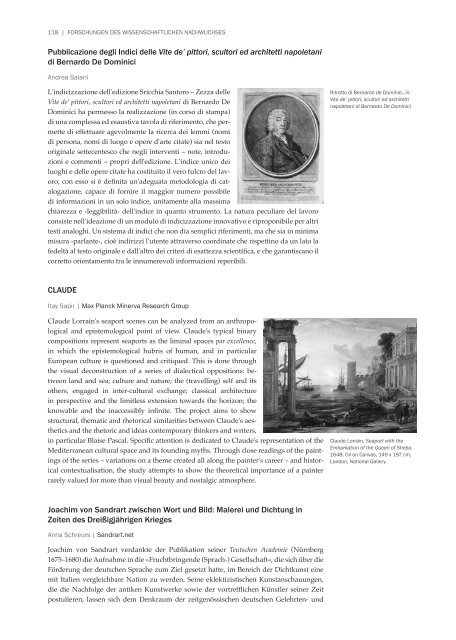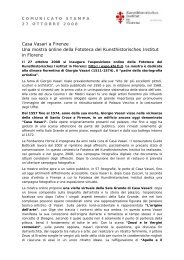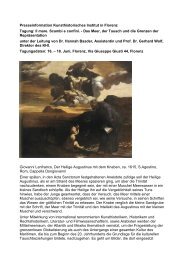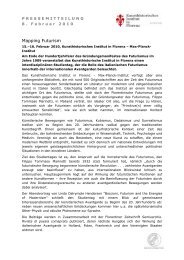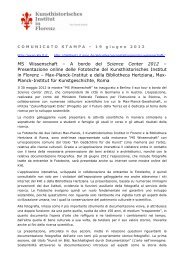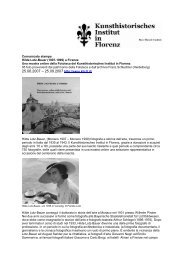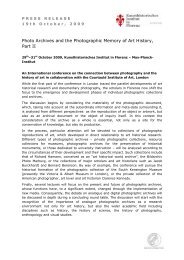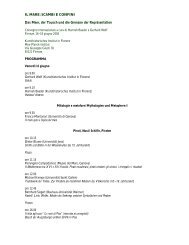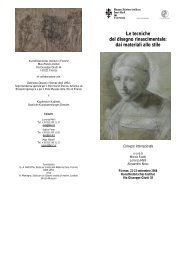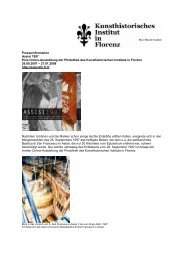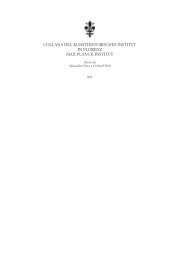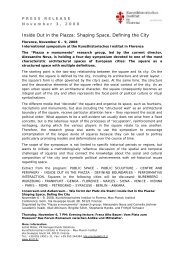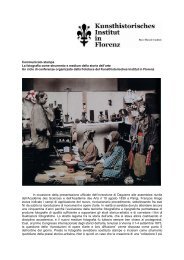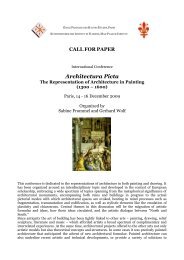forschungsbericht november 2008 – juli 2012 - Kunsthistorisches ...
forschungsbericht november 2008 – juli 2012 - Kunsthistorisches ...
forschungsbericht november 2008 – juli 2012 - Kunsthistorisches ...
Erfolgreiche ePaper selbst erstellen
Machen Sie aus Ihren PDF Publikationen ein blätterbares Flipbook mit unserer einzigartigen Google optimierten e-Paper Software.
118 | FORSCHUNGEN DES WISSENSCHAFTLICHEN NACHWUCHSES<br />
Pubblicazione degli Indici delle Vite de’ pittori, scultori ed architetti napoletani<br />
di Bernardo De Dominici<br />
Andrea Salani<br />
L'indicizzazione dell'edizione Sricchia Santoro <strong>–</strong> Zezza delle<br />
Vite de’ pittori, scultori ed architetti napoletani di Bernardo De<br />
Dominici ha permesso la realizzazione (in corso di stampa)<br />
di una complessa ed esaustiva tavola di riferimento, che permette<br />
di effettuare agevolmente la ricerca dei lemmi (nomi<br />
di persona, nomi di luogo e opere d'arte citate) sia nel testo<br />
originale settecentesco che negli interventi <strong>–</strong> note, introduzioni<br />
e commenti <strong>–</strong> propri dell'edizione. L'indice unico dei<br />
luoghi e delle opere citate ha costituito il vero fulcro del lavoro;<br />
con esso si è definita un'adeguata metodologia di catalogazione,<br />
capace di fornire il maggior numero possibile<br />
di informazioni in un solo indice, unitamente alla massima<br />
chiarezza e ›leggibilità‹ dell'indice in quanto strumento. La natura peculiare del lavoro<br />
consiste nell'ideazione di un modulo di indicizzazione innovativo e riproponibile per altri<br />
testi analoghi. Un sistema di indici che non dia semplici riferimenti, ma che sia in minima<br />
misura ›parlante‹, cioè indirizzi l'utente attraverso coordinate che rispettino da un lato la<br />
fedeltà al testo originale e dall'altro dei criteri di esattezza scientifica, e che garantiscano il<br />
corretto orientamento tra le innumerevoli informazioni reperibili.<br />
Ritratto di Bernardo de Dominici, in:<br />
Vite de’ pittori, scultori ed architetti<br />
napoletani di Bernardo De Dominici<br />
CLAUDE<br />
Itay Sapir | Max Planck Minerva Research Group<br />
Claude Lorrain's seaport scenes can be analyzed from an anthropological<br />
and epistemological point of view. Claude's typical binary<br />
compositions represent seaports as the liminal spaces par excellence,<br />
in which the epistemological hubris of human, and in particular<br />
European culture is questioned and critiqued. This is done through<br />
the visual deconstruction of a series of dialectical oppositions: between<br />
land and sea; culture and nature; the (travelling) self and its<br />
others, engaged in inter-cultural exchange; classical architecture<br />
in perspective and the limitless extension towards the horizon; the<br />
knowable and the inaccessibly infinite. The project aims to show<br />
structural, thematic and rhetorical similarities between Claude's aesthetics<br />
and the rhetoric and ideas contemporary thinkers and writers,<br />
in particular Blaise Pascal. Specific attention is dedicated to Claude's representation of the<br />
Mediterranean cultural space and its founding myths. Through close readings of the paintings<br />
of the series <strong>–</strong> variations on a theme created all along the painter's career <strong>–</strong> and historical<br />
contextualisation, the study attempts to show the theoretical importance of a painter<br />
rarely valued for more than visual beauty and nostalgic atmosphere.<br />
Claude Lorrain, Seaport with the<br />
Embarkation of the Queen of Sheba,<br />
1648, Oil on Canvas, 149 x 197 cm,<br />
London, National Gallery<br />
Joachim von Sandrart zwischen Wort und Bild: Malerei und Dichtung in<br />
Zeiten des Dreißigjährigen Krieges<br />
Anna Schreurs | Sandrart.net<br />
Joachim von Sandrart verdankte der Publikation seiner Teutschen Academie (Nürnberg<br />
1675<strong>–</strong>1680) die Aufnahme in die »Fruchtbringende (Sprach-) Gesellschaft«, die sich über die<br />
Förderung der deutschen Sprache zum Ziel gesetzt hatte, im Bereich der Dichtkunst eine<br />
mit Italien vergleichbare Nation zu werden. Seine eklektizistischen Kunstanschauungen,<br />
die die Nachfolge der antiken Kunstwerke sowie der vortrefflichen Künstler seiner Zeit<br />
postulieren, lassen sich dem Denkraum der zeitgenössischen deutschen Gelehrten- und


